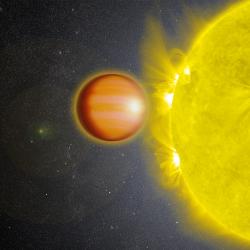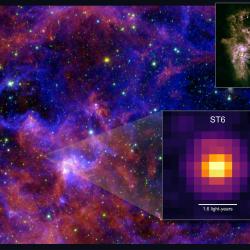NANOGrav Finds Possible ‘First Hints’ of Low-frequency Gravitational Waves
New analyses of pulsar radio emissions may reveal a long sought-after way to detect gravitational waves
In data gathered and analyzed over 13 years, the North American Nanohertz Observatory for Gravitational Waves (NANOGrav) found an intriguing low-frequency signal that may be attributable to gravitational waves. Caused by the movements of incredibly massive objects, such as black holes orbiting each other or neutron stars colliding, gravitational waves are ripples in space-time that cannot be observed by traditional telescopes.
NANOGrav researchers studying the signals from distant pulsars—small, dense stars that rapidly rotate, emitting beamed radio waves, much like a lighthouse—used radio telescopes to collect data that may indicate the effects of gravitational waves. Their research was presented in two studies published in the January 2021 issue of Astrophysical Journal Supplements.
“This announcement brings together a collection of recent papers and is the first demonstration that the detection of a signal in the dataset that may be attributable to gravitational waves,” said Elizabeth Ferrara, an associate research scientist in the Department of Astronomy at the University of Maryland and a NASA research scientist who is a co-author of the study. “At the moment, the signal is significant, but NANOGrav is not yet able to pin the source to gravitational waves. However, this is a necessary first step in the process of opening the next window on the gravitational universe.”
Further studies will help the researchers confirm whether they have detected gravitational waves and where they came from.
“It is incredibly exciting to see such a strong signal emerge from the data,” said Joseph Simon, lead researcher on the research papers. “However, because the gravitational-wave signal we are searching for spans the entire duration of our observations, we need to carefully understand our noise. This leaves us in a very interesting place, where we can strongly rule out some known noise sources, but we cannot yet say whether the signal is indeed from gravitational waves. For that, we will need more data.”
NANOGrav has been able to rule out some effects caused by things other than gravitational waves, such as interference from the matter in our own solar system or certain errors in the data collection. These newest findings set up direct detection of gravitational waves as the possible next major step for NANOGrav and other members of the International Pulsar Timing Array (IPTA), a collaboration of researchers using the world’s largest radio telescopes.
NANOGrav chose to study the signals from pulsars because they serve as detectable, dependable galactic clocks. These small, dense stars spin rapidly, sending pulses of radio waves at precise intervals toward Earth. Pulsars are in fact commonly referred to as the universe’s timekeepers, and this unique trait has made them useful for astronomical study.
But gravitational waves can interrupt this observed regularity, as the ripples cause space-time to undergo tiny amounts of stretching and shrinking. Those ripples result in extremely small deviations in the expected times for pulsar signals arriving on Earth. Such deviations indicate that the position of the Earth has shifted slightly.
By studying the timing of the regular signals from many pulsars scattered over the sky at the same time, known as a “pulsar timing array,” NANOGrav works to detect minute changes in the Earth’s position due to gravitational waves stretching and shrinking space-time.
“NANOGrav has been building to the first detection of low frequency gravitational waves for over a decade and today’s announcement shows that they are on track to achieving this goal,” said Pedro Marronetti, National Science Foundation (NSF) program director for gravitational physics. “The insights that we will gain on cosmology and galaxy formation are truly unparalleled.”
NANOGrav is a collaboration of U.S. and Canadian astrophysicists and is an NSF Physics Frontiers Center (PFC). Maura McLaughlin, co-director of the NANOGrav PFC, added, "We are so grateful for the support of the NANOGrav PFC, that's allowed us to dramatically increase both the number of pulsars being timed and the number of participants working on data analysis over the past six years.”
NANOGrav created its pulsar timing array by studying 47 of the most stably rotating “millisecond pulsars,” as reported in the Astrophysical Journal Supplements. Not all pulsars can be used to detect the signals that NANOGrav seeks—only the most stably rotating and longest-studied pulsars will do. These pulsars spin hundreds of times a second, with incredible stability, which is necessary to obtain the precision required to detect gravitational waves.
Of the 47 pulsars studied, 45 had sufficiently long datasets of at least three years to use for the analysis. Researchers studying the data uncovered a spectral signature, a low-frequency noise feature, that is the same across multiple pulsars. The timing changes NANOGrav studies are so small that the evidence isn’t apparent when studying any individual pulsar, but in aggregate, they add up to a significant signature.
Potential Next Steps
In order to confirm direct detection of a signature from gravitational waves, NANOGrav’s researchers will have to find a distinctive pattern in the signals between individual pulsars. At this point, the signal is too weak for such a pattern to be distinguishable. Boosting the signal requires NANOGrav to expand its dataset to include more pulsars studied for even longer lengths of time, which will increase the array’s sensitivity. In addition, by pooling NANOGrav's data together with those from other pulsar timing array experiments, a joint effort by the IPTA may reveal such a pattern.
At the same time, NANOGrav is developing techniques to ensure the detected signal could not be from another source. NanoGrav researchers are producing computer simulations that help test whether the detected noise could be caused by effects other than gravitational waves, in order to avoid a false detection.
“Trying to detect gravitational waves with a pulsar timing array requires patience,” said Scott Ransom, from the National Radio Astronomy Observatory, and the current chair of NANOGrav. “We’re currently analyzing over a dozen years of data, but a definitive detection will likely take a couple more. It’s great that these new results are exactly what we would expect to see as we creep closer to a detection.”
Like light from distant objects, gravitational waves are a cosmic messenger signal—one that holds great potential for understanding “dark” objects, like black holes. In 2015, NSF’s Laser Interferometer Gravitational-Wave Observatory (LIGO) made the first direct observation of gravitational waves.
LIGO and its counterparts, Virgo in Europe and Kagra in Japan, use purpose-built interferometry facilities to detect high-frequency gravitational waves. However, unlike the transient signals detected by LIGO, Virgo and Kagra, low-frequency gravitational waves are persistent, requiring many years of data to detect. Over the past decade, NANOGrav used existing radio telescopes to search for evidence of these low-frequency gravitational waves, which have the potential to help answer longstanding questions in astrophysics, including how massive black holes form and how galaxies merge.
###
This story was adapted from text provided by NANOGrav.
This work is supported by the National Science Foundation (NSF) Physics Frontiers Center (Award No. 1430284). NANOGrav uses data from two NSF-supported instruments: the Green Bank Telescope a facility of the National Science Foundation operated in West Virginia under cooperative agreement by Associated Universities, Inc. and Arecibo Observatory, a facility of the National Science Foundation operated in Puerto Rico under cooperative agreement (#AST-1744119) by the University of Central Florida (UCF) in alliance with Universidad Ana G. Méndez (UAGM) and Yang Enterprises (YEI), Inc.
The research papers, The NANOGrav 12.5 yr Data Set: Observations and Narrowband Timing of 47 Millisecond Pulsars, Md F. Alam et al, and The NANOGrav 12.5 yr Data Set: Wideband Timing of 47 Millisecond Pulsars, Md F. Alam et al, were published in the January 2021 issue of Astrophysical Journal Supplements.
Media Relations Contact: Abby Robinson, 301-405-5845, abbyr@umd.edu
University of Maryland
College of Computer, Mathematical, and Natural Sciences
2300 Symons Hall
College Park, Md. 20742
www.cmns.umd.edu
@UMDscience
About the College of Computer, Mathematical, and Natural Sciences
The College of Computer, Mathematical, and Natural Sciences at the University of Maryland educates more than 9,000 future scientific leaders in its undergraduate and graduate programs each year. The college's 10 departments and more than a dozen interdisciplinary research centers foster scientific discovery with annual sponsored research funding exceeding $200 million.








